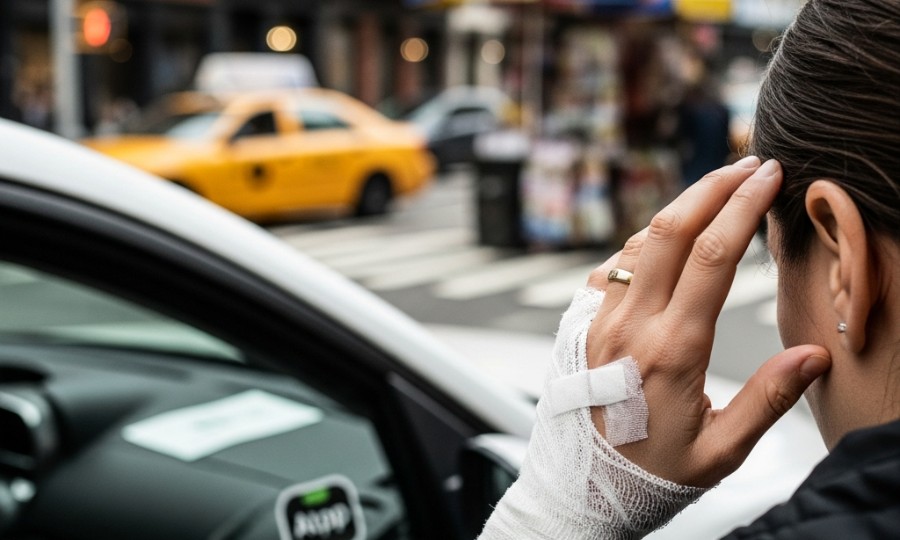
When you hop into a rideshare in New York City – be it an Uber, Lyft, or another service – you’re probably thinking about convenience, getting to your destination quickly, or maybe just avoiding the subway during rush hour. You’re certainly not expecting a life-altering crash. But here’s the uncomfortable truth: rideshare accidents happen, and when they do, the injuries can be far more serious than just a few bumps and bruises. What exactly constitutes a ‘serious injury‘ in the eyes of the law, especially when you’re dealing with the complex world of rideshare insurance and settlements in the five boroughs? It’s a question that keeps many accident victims up at night, isn’t it?
Understanding the full scope of your injuries and their long-term impact is absolutely critical, not just for your health but for your financial future. In New York, specific legal definitions of ‘serious injury‘ come into play, profoundly influencing your ability to pursue compensation beyond basic no-fault benefits. We’re talking about injuries that don’t just heal in a few weeks; they can reshape your life, affecting your ability to work, enjoy hobbies, and even perform daily tasks. Let’s delve into what these serious injuries often look like and how they can impact potential settlements.
Beyond the Visible: Common Serious Injuries in NYC Rideshare Crashes
It’s easy to dismiss aches and pains after an accident, but some injuries have a way of revealing their true severity over time. Often, the adrenaline of the moment can mask significant damage. In the context of a rideshare accident in a bustling place like NYC, where impacts can be severe, we frequently see particular types of serious injuries:
- Traumatic Brain Injuries (TBIs): These can range from concussions to more severe brain damage. Symptoms might not appear immediately, but they can include persistent headaches, dizziness, memory loss, mood changes, and even cognitive difficulties. TBIs often require extensive neurological care and rehabilitation, sometimes for years. Can you imagine struggling with basic tasks because of a TBI caused by someone else’s negligence?
- Spinal Cord Injuries: From herniated discs to complete paralysis, spinal injuries are devastating. They can result in chronic pain, loss of mobility, and permanent disability. The cost of long-term care, adaptive equipment, and home modifications for a severe spinal injury can be astronomical.
- Severe Fractures: While a broken bone might sound straightforward, complex fractures (especially compound or comminuted fractures) often require multiple surgeries, pins, plates, and extensive physical therapy. If a fracture affects a joint or results in nerve damage, it can lead to lifelong pain and limited function.
- Internal Organ Damage: The blunt force trauma of a car crash can cause internal bleeding, ruptured organs, or other damage that might not be immediately apparent but can be life-threatening if not diagnosed and treated promptly.
- Catastrophic Injuries: This umbrella term includes severe burns, amputations, or injuries leading to permanent disfigurement. These injuries inherently carry immense physical, emotional, and financial burdens.
The key takeaway here is that ‘serious’ isn’t just about pain; it’s about the long-term functional impairment, the medical interventions required, and the impact on your quality of life. New York State’s no-fault law mandates that to step outside the no-fault system and sue for pain and suffering, your injury must meet a serious injury threshold. This typically includes fractures, significant disfigurement, permanent limitation of use of a body organ or member, or a medically determined injury that prevents you from performing substantially all of your usual daily activities for at least 90 out of the 180 days following the accident. It’s a high bar, which is why detailed medical documentation is paramount.
Navigating NYC’s Unique Rideshare Insurance Landscape
Here’s the thing about rideshare accidents in New York City: they’re not like your typical fender bender. The insurance landscape is far more intricate, thanks to specific regulations governing companies like Uber and Lyft. New York State law, particularly the rules set by the Taxi & Limousine Commission (TLC), requires rideshare companies to carry significant insurance policies, but the coverage level often depends on what ‘period’ the driver was in at the time of the accident.
- Period 0 (App Off): The driver’s personal insurance applies.
- Period 1 (App On, Waiting for a Ride Request): Rideshare company’s contingent liability policy kicks in, usually offering lower coverage (e.g., $50,000 in bodily injury per person, $100,000 per accident, and $25,000 in property damage).
- Period 2 & 3 (Accepting a Ride Request, En Route to Pick Up, or During a Trip): This is where the big policies come into play, often up to $1,250,000 in liability coverage. This substantial policy is what often makes significant settlements possible for serious injuries.
Why does this matter so much? Because if you’ve suffered a TBI or a spinal injury, your medical bills alone could quickly exhaust the lower Period 1 coverage. Knowing which period the driver was in is crucial for identifying the available insurance pool. This isn’t something you want to guess at, believe me. Your attorney will meticulously investigate these details, often relying on rideshare company data, police reports, and witness statements to establish the facts.
Factors Influencing Your Settlement: It’s More Than Just Medical Bills
When we talk about ‘settlements’ for serious injuries, we’re not just looking at a check for your emergency room visit. A comprehensive settlement aims to cover the full spectrum of your losses, both economic and non-economic. What factors truly drive the value of a settlement in an NYC rideshare accident case? It’s a complex equation, but some key elements stand out:
-
Severity and Permanence of Injuries: As discussed, truly serious, life-altering injuries (like those leading to permanent disability, chronic pain, or significant disfigurement) will command higher settlements. The more profound the impact on your daily life, the greater the potential value. This is where detailed medical records, expert testimony from doctors, and even vocational assessments become incredibly important.
-
Medical Expenses (Past and Future): This includes everything from ambulance rides and surgeries to rehabilitation, prescriptions, and ongoing therapy. For severe injuries, future medical costs can be immense, and a settlement must account for these projected expenses over your lifetime. We’re talking about things like future surgeries, continued physical therapy, home health aides, or specialized equipment. It’s not uncommon for these projections to be in the hundreds of thousands, or even millions, of dollars.
-
Lost Wages and Earning Capacity: If your injuries prevent you from working, you’re entitled to compensation for lost income. For serious injuries, this isn’t just about the weeks or months you missed right after the accident. If you can no longer perform your previous job or your earning capacity is permanently diminished, a settlement needs to reflect that long-term financial loss. This is often calculated with the help of economic experts.
-
Pain and Suffering: This is a significant, yet often challenging, component to quantify. It accounts for the physical pain, emotional distress, mental anguish, loss of enjoyment of life, and inconvenience caused by your injuries. How do you put a price on not being able to play with your kids, pursue your favorite hobby, or even sleep soundly without pain? Jurors (and insurance adjusters) consider the severity, duration, and impact of your pain and suffering on your overall well-being. This is where a skilled attorney can really articulate your story.
-
Liability and Fault: New York is a comparative negligence state. If you are found partially at fault for the accident, your settlement could be reduced by your percentage of fault. However, in most rideshare accidents involving passengers, the rideshare driver or the driver of another vehicle is typically found to be primarily at fault. Clear evidence of the other party’s negligence (e.g., distracted driving, speeding) strengthens your case considerably.
The truth is, insurance companies are businesses, and they’re always looking to minimize payouts. That’s why having a professional advocate on your side who understands the intricacies of New York personal injury law and rideshare regulations is so vital. They can build a robust case, negotiate aggressively, and ensure all potential damages are considered.
The Long-Term Realities and Why It Matters
Beyond the immediate medical care and legal battles, serious injuries from rideshare accidents can have profound, lasting effects. We’re talking about a complete shift in your quality of life. You might find yourself unable to return to your old job, facing a mountain of medical debt, or struggling with chronic pain that never truly goes away. This isn’t just about physical recovery; it’s about emotional and psychological healing too.
I’ve seen firsthand how victims grapple with anxiety, depression, and even PTSD after a traumatic accident. These ‘invisible’ injuries are just as real and can be just as debilitating as a broken bone. A comprehensive settlement isn’t just about present costs; it’s about providing you with the resources to adapt, recover, and rebuild your life as much as possible in the face of these long-term challenges. It’s about securing your future, so you don’t have to carry the financial burden of someone else’s mistake for the rest of your life. Don’t you deserve that peace of mind?
Taking Your Next Steps After a Serious Rideshare Injury
If you or a loved one has suffered a serious injury in an NYC rideshare accident, the path forward can feel overwhelming. You’re likely dealing with pain, medical appointments, and financial stress, all while trying to understand a complex legal system. Don’t go it alone. Your priority should always be your health and recovery, but securing your legal rights is a close second.
Gathering evidence, understanding insurance policies, and negotiating with adjusters are intricate tasks that require specific legal expertise. Seek out a qualified New York personal injury attorney who has a proven track record with rideshare accident cases. They can assess your situation, explain your options, and tirelessly advocate for the full and fair compensation you deserve. You’ve been through enough; let a professional handle the legal heavy lifting so you can focus on healing.
Free Case Consultation
Injured in an accident? Contact Rosenberg, Minc, Falkoff & Wolff for a free and confidential case review with an experienced NYC personal injury attorney.


